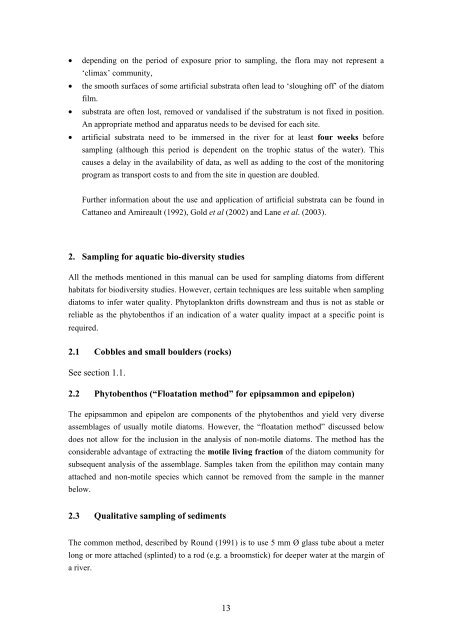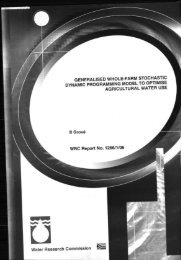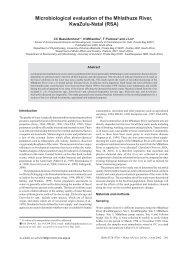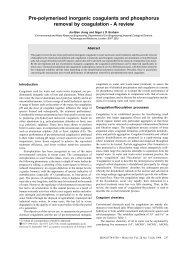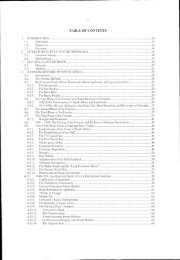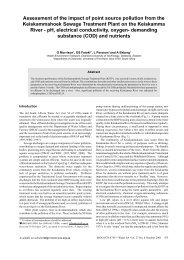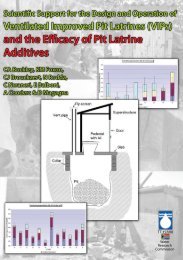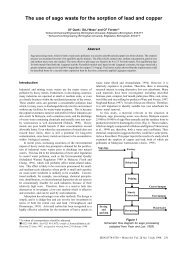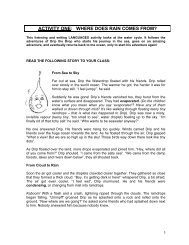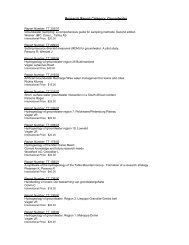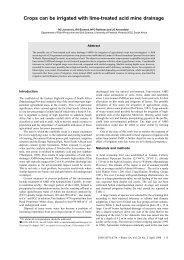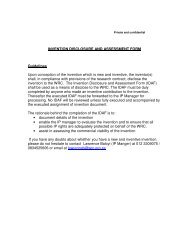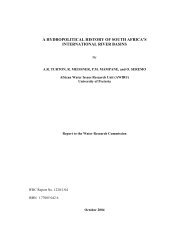A Methods Manual for the Collection, Preparation and Analysis of ...
A Methods Manual for the Collection, Preparation and Analysis of ...
A Methods Manual for the Collection, Preparation and Analysis of ...
You also want an ePaper? Increase the reach of your titles
YUMPU automatically turns print PDFs into web optimized ePapers that Google loves.
depending on <strong>the</strong> period <strong>of</strong> exposure prior to sampling, <strong>the</strong> flora may not represent a‘climax’ community,<strong>the</strong> smooth surfaces <strong>of</strong> some artificial substrata <strong>of</strong>ten lead to ‘sloughing <strong>of</strong>f’ <strong>of</strong> <strong>the</strong> diatomfilm.substrata are <strong>of</strong>ten lost, removed or v<strong>and</strong>alised if <strong>the</strong> substratum is not fixed in position.An appropriate method <strong>and</strong> apparatus needs to be devised <strong>for</strong> each site.artificial substrata need to be immersed in <strong>the</strong> river <strong>for</strong> at least four weeks be<strong>for</strong>esampling (although this period is dependent on <strong>the</strong> trophic status <strong>of</strong> <strong>the</strong> water). Thiscauses a delay in <strong>the</strong> availability <strong>of</strong> data, as well as adding to <strong>the</strong> cost <strong>of</strong> <strong>the</strong> monitoringprogram as transport costs to <strong>and</strong> from <strong>the</strong> site in question are doubled.Fur<strong>the</strong>r in<strong>for</strong>mation about <strong>the</strong> use <strong>and</strong> application <strong>of</strong> artificial substrata can be found inCattaneo <strong>and</strong> Amireault (1992), Gold et al (2002) <strong>and</strong> Lane et al. (2003).2. Sampling <strong>for</strong> aquatic bio-diversity studiesAll <strong>the</strong> methods mentioned in this manual can be used <strong>for</strong> sampling diatoms from differenthabitats <strong>for</strong> biodiversity studies. However, certain techniques are less suitable when samplingdiatoms to infer water quality. Phytoplankton drifts downstream <strong>and</strong> thus is not as stable orreliable as <strong>the</strong> phytobenthos if an indication <strong>of</strong> a water quality impact at a specific point isrequired.2.1 Cobbles <strong>and</strong> small boulders (rocks)See section 1.1.2.2 Phytobenthos (“Floatation method” <strong>for</strong> epipsammon <strong>and</strong> epipelon)The epipsammon <strong>and</strong> epipelon are components <strong>of</strong> <strong>the</strong> phytobenthos <strong>and</strong> yield very diverseassemblages <strong>of</strong> usually motile diatoms. However, <strong>the</strong> “floatation method” discussed belowdoes not allow <strong>for</strong> <strong>the</strong> inclusion in <strong>the</strong> analysis <strong>of</strong> non-motile diatoms. The method has <strong>the</strong>considerable advantage <strong>of</strong> extracting <strong>the</strong> motile living fraction <strong>of</strong> <strong>the</strong> diatom community <strong>for</strong>subsequent analysis <strong>of</strong> <strong>the</strong> assemblage. Samples taken from <strong>the</strong> epilithon may contain manyattached <strong>and</strong> non-motile species which cannot be removed from <strong>the</strong> sample in <strong>the</strong> mannerbelow.2.3 Qualitative sampling <strong>of</strong> sedimentsThe common method, described by Round (1991) is to use 5 mm Ø glass tube about a meterlong or more attached (splinted) to a rod (e.g. a broomstick) <strong>for</strong> deeper water at <strong>the</strong> margin <strong>of</strong>a river.13


